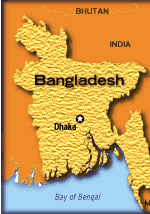|
|
Bangladesh

The Peoples
Republic of Bangladesh as it is officially
called is situated in Southern Asia bordering
the Bay of Bengal, between Burma and India.
Etymologically, the word Bangladesh is derived
from the cognate VANGA, which literally means
wetland. Its occupies the delta where the rivers
Ganga, Brahmaputra, Meghna, and their
tributaries meet and drain into the Bay of
Bengal. Such a wet environment creates arable
land, and therefore the Bangladeshis are
traditionally an agrarian economy. Its network
of rivers and canals make it the largest
riverine in the world. However the silt-laden,
unstable land makes it vulnerable to frequent
monsoons and floods. Formally known as East
Pakistan, Bangladesh won independence after a
brief war in 1971.
The major disasters that strike Bangladesh are
floods, tropical cyclones and landslides.
 Floods
are an annual occurrence in Bangladesh. The four
main kinds of natural floods affecting
Bangladesh are flash floods, river floods,
rainwater floods, and storm surges. Many floods
are attributed to human activities too. Floods
are an annual occurrence in Bangladesh. The four
main kinds of natural floods affecting
Bangladesh are flash floods, river floods,
rainwater floods, and storm surges. Many floods
are attributed to human activities too.
Flash Floods
are caused by run-off during exceptionally heavy
rainfall occurring over neighbouring upland
areas. They occur most frequently, sometimes
several times a year, at the foot of the
northern and easter hills. They are also common
along the Teesta, Atrai and little Jamuna rivers
in the northwest and in valleys within upland
regions. Flash Floods rise and fall rapidly,
usually within a few days. They may also flow
rapidly along river channels and over the land.
Water levels in some eastern rivers can rise by
several meters within 24-28 hours. They do not
however cause extensive damage to crops and
property.
River Floods
result from snowmelt in the high Himalayas and
heavy monsoon rainfall over the Himalayas, the
Assam and the Tripura Hills the upper
Brahmaputra and Ganges floodplains, outside
Bangladesh. River floods extend beyond the
active floodplains and damage crops on parts of
the adjoining meander floodplains mainly
alongside distributary channels. However the
timing and duration of the floods are important
determinants of crop damage. Sediments deposited
in channels reduce the drainage capacity of
minor rivers, road and railway bridges as well
as irrigation and drainage canals. Severe
floods, which cause extensive damage to crops
and property, occur at an average intervals of
7-10 years.
Rainwater Floods
are caused by heavy rainfall occurring over
floodplain and terrace areas within Bangladesh.
Heavy pre-monsoon rainfall between the months of
April and May cause local run-off to accumulate
in floodplain depressions and in the lower parts
of valleys within the Madhupur Tract. Later
between the months of June and August, local
rainwater is increasingly ponded on the land by
the rising water-levels in adjoining rivers.
Rainwater flooding is characteristic of meander
floodplains, major floodplain basins, and old
estuarine floodplains. Early floods cause damage
to rice and jute crops.
Storm Surges
are raised sea levels caused by a combination of
low barometric pressure and strong onshore winds
associated with tropical cyclones. They cause
sudden but temporary, flooding of coastal areas
with seawater or brackish estuarine water for a
few kilometers inland during the passage of
cyclone and are responsible for most of the
casualties caused by cyclones. Floods caused by
cyclones and the mitigation measures they
require differ from that occurring on the river
floodplains.
Man-made Floods
are caused mainly by the sudden breaching of an
embankment at a time when there is a difference
in elevation of several meters between the
external river level and the land inside the
embankment. It can also be caused by the release
of water from dams at high rates, failure of
major dam or barrage on one of the major rivers
or their tributaries and ponding of water behind
road, railway and flood embankments following
heavy rainfall.
Links
|
|

